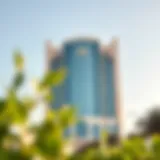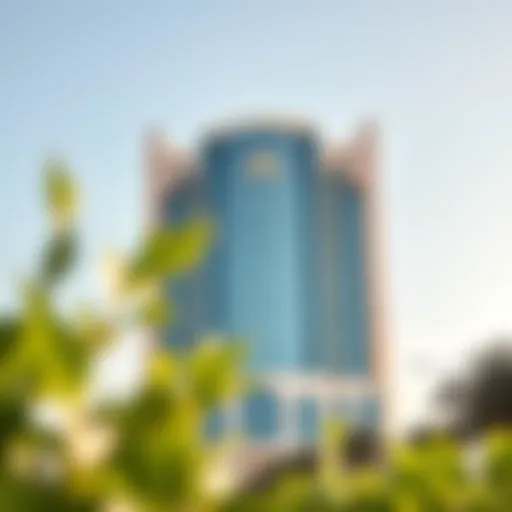Exploring the Butterfly Garden in Dubai
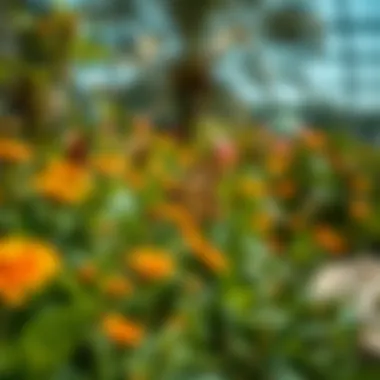

Intro
Tucked away in the bustling metropolis of Dubai lies a small yet captivating haven known as the Butterfly Garden. This garden is not just a feast for the eyes; it stands as a testament to the delicate balance of nature amid the city's impressive skyline. As one wanders through pathways flanked by colorful blooms and fluttering wings, the essence of biodiversity and conservation takes center stage.
The Butterfly Garden boasts an impressive collection of over 15,000 butterflies, representing various species that dance gracefully through the air. They flutter and glide, providing an ethereal experience for those who visit. This exploration is not solely about aesthetics; it unveils the rich tapestry of life that thrives within these carefully curated habitats.
Moreover, the garden plays an integral role in environmental education. Through various outreach programs and workshops, it educates residents and tourists on the importance of biodiversity and the fragility of ecosystems. This raises awareness about sustainability and conservation efforts needed to preserve our planet's natural beauty.
For anyone planning a visit, knowing the ins and outs of the garden can enhance the experience. Accessibility, surrounding attractions, and engaging activities are key aspects that round out a visit. This exploration will dive deep into these areas, ensuring that one not only witnesses the beauty of the butterflies but also appreciates their ecological significance. The journey starts here, where urban life meets nature in a stunning display of vibrant colors and harmonious coexistence.
Prelims to Dubai Butterfly Garden
The Butterfly Garden in Dubai stands as a notable sanctuary within the bustling metropolis, offering an escape into a vibrant ecosystem that brims with life. This section serves to illuminate the significance of this enchanting venue, pointing to both its ecological contributions and the broader awareness it fosters among visitors about the delicate balance of nature. Through engaging with such a distinguished habitat, one can glean insights into the role that butterflies play in sustaining biodiversity—an understanding that is sorely needed in a world increasingly overshadowed by urban sprawl.
Overview and Purpose
Nestled in the heart of Dubai, the Butterfly Garden aims not just to captivate eyes, but also to educate and inspire. The garden is home to over 15,000 butterflies, showcasing around 50 different species from across the globe. Each fluttering creature adds to the garden's narrative, illustrating the importance of conservation efforts and how they intertwine with both local and global ecosystems.
In addition to providing a breathtaking spectacle, the garden serves a greater purpose: it acts as an educational platform, illuminating the need for environmental stewardship. Here, visitors can engage with practical insights about butterfly biology and the intricate dependencies these fragile creatures have within their ecosystems. This educational mission is vital, especially in urban settings like Dubai, where such natural retreats may not be immediately accessible.
Location and Accessibility
The Butterfly Garden is conveniently located in the Dubai Miracle Garden area, making it easily reachable for both residents and tourists. With its close proximity to major transportation hubs, visitors can access the garden via car, taxi, or public transit without much fuss.
For those navigating the local landscape, detailed signage and clear directions enhance the journey, ensuring that individuals—from families on a leisurely outing to avid nature enthusiasts—find their way without unnecessary hassle. Adequate parking facilities also cater to the influx of visitors, signaling the garden's commitment to accessibility.
One of the unique features of the garden is its design, which allows for a leisurely stroll through various sections, each one thoughtfully curated to highlight different aspects of butterfly life and their habitats.
For more information, visit the Dubai Butterfly Garden official site or check local guides at Visit Dubai for tips on maximizing your experience.
"The Butterfly Garden is not merely a visual feast but a dialogue between nature and humanity, highlighting what is at stake if we do not acknowledge our environmental responsibilities."
Through its exquisite collection and thoughtful layout, the garden stands as a testament to the beauty of nature and the essential role it plays in our urban lives.
Design and Features of the Garden
The design and features of the Butterfly Garden in Dubai play a pivotal role in creating an environment that fosters both biodiversity and visitor engagement. Understanding these elements not only enhances the aesthetic appeal of the garden but also showcases the thoughtfulness behind its construction. Visually striking and functionally wise, the architecture and climate control systems contribute massively to the experience offered to visitors.
Architectural Layout
The architectural layout of the Butterfly Garden is a careful blend of aesthetic beauty and ecological functionality. With a design that mirrors the complexity of butterfly habitats found in nature, the garden encompasses several themed zones. Each zone is tailored to mimic distinct ecosystems, providing an ideal atmosphere for various butterfly species to thrive.
One of the standout features is the use of dome-shaped structures made of sustainable materials. These domes are adorned with exotic plants that provide both nectar and host for butterflies. The design benefits not just the insects but also enhances the experience for the visitors. Wanderers meandering through the winding paths get a chance to witness butterflies fluttering amid lush greenery, creating a mesmerizing visual spectacle.
Additionally, the spatial arrangement of zones allows for a smooth flow of foot traffic while minimizing disturbance to the butterflies. The tranquil pathways, dotted with seating areas, are not just practical but encourage visitors to take their time observing and appreciating this unique ecosystem. This thoughtful design fosters not just an engaging experience but also an educational one, as visitors immerse themselves in the beauty of nature.
Climate Control Systems
The climate control systems are another integral part of the garden's design, ensuring a stable environment that mimics the butterflies' natural habitats. In the arid climate of Dubai, maintaining an optimal climate for the butterflies is fundamental. This is achieved through innovative technology that regulates temperature and humidity within the domes.
The use of solar energy to power these systems shows a commitment to sustainability. By harnessing the power of the sun, the garden can maintain tropical conditions necessary for the butterflies without contributing to environmental degradation. This eco-friendly approach not only assures a consistent atmosphere for the butterflies but also aligns with global sustainability goals.
Moreover, the garden utilizes an advanced misting system that provides humidity at levels conducive to butterfly health while also enhancing the overall visitor experience. The gentle mist creates a refreshing microclimate, allowing guests to stroll comfortably even during hotter days. The interplay of technology and nature embodies a forward-thinking approach, redefining how urban spaces can harmonize with the environment.
A well-designed butterfly garden acts as a sanctuary for these insects, providing a safe haven while educating visitors about their importance in the ecosystem.
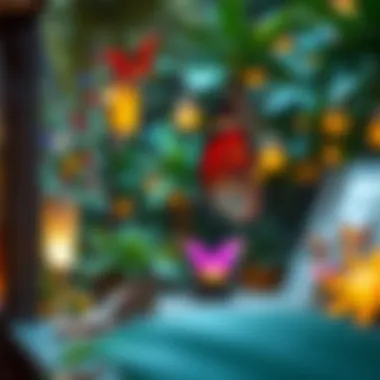

By understanding the architectural layout and climate control methods used in the Butterfly Garden, visitors and researchers alike find significant insights into how design influences ecological and educational outcomes. The combination of visual beauty and functional necessity serves as a model for future conservation efforts.
Biodiversity within the Garden
Biodiversity is the cornerstone of any thriving ecosystem, and the Butterfly Garden in Dubai puts this fact at the forefront. Not only does it serve as a sanctuary for butterflies, but it also creates a balanced environment that supports various species. This rich biodiversity has benefits that ripple through the ecosystem. A diverse range of species ensures that the garden is resilient and capable of adapting to changes. It also enhances the overall aesthetic value, providing a haven for both wildlife and visitors alike. By fostering this biodiversity, the garden plays a crucial role in sustainability and conservation efforts, ultimately impacting the local ecology of Dubai and beyond.
Varieties of Butterflies
Within the Butterfly Garden, visitors are treated to an astonishing array of butterfly species that flutter gracefully among lush greenery. Highlighting these various species adds to the garden's charm and ecological significance. Some of the most notable varieties include:
- Swallowtail Butterflies: Recognized by their striking tails and vibrant colors, these butterflies are known for their large size and are often viewed as symbols of beauty in nature.
- Morpho Butterflies: Famous for their iridescent blue wings, Morpho butterflies are a sight to behold. Their unique appearance makes them popular among photographers and nature enthusiasts.
- Monarch Butterflies: These are not just ordinary butterflies; Monarchs are remarkable migrators, traveling thousands of miles during their seasonal migrations.
- Glasswing Butterflies: With their translucent wings, they offer a captivating look as they flit about, seemingly in midair.
As a visitor strolls through the garden's pathways, it's almost impossible not to be captivated by the fluttering dance of these beautiful creatures. Each species plays a role in pollination, helping to foster plant growth while also maintaining the equilibrium needed for other wildlife.
Other Wildlife Species
The Butterfly Garden is not solely dedicated to butterflies. A wealth of other wildlife thrives here, creating a dynamic ecosystem that supports various life forms.
- Bird Species: Various birds, particularly those that enjoy nectar like hummingbirds, contribute to the pollination process while adding a lively buzz to the garden. Their songs and animations enrich the environment, offering visitors an immersive experience.
- Insects: Beyond butterflies, myriad insects call this garden home. Beetles, bees, and even ladybugs are essential contributors to pollination and pest control.
- Small Mammals: Occasionally, one might spot small mammals such as rabbits or hedgehogs. They often navigate through the underbrush and contribute to nutrient cycling in the soil.
- Aquatic Life: If ponds or water features exist, expect to see frogs, fish, and various aquatic plants thriving, creating a mini-ecosystem that contributes to overall biodiversity.
These various species work in harmony, contributing to the garden's ecological balance. Each participant, no matter how small, plays a significant role in sustaining the environment. By showcasing this biodiversity, the Butterfly Garden educates visitors on the interconnectedness of species and the vital importance of preserving these relationships.
Educational Programs and Conservation Efforts
The Butterfly Garden in Dubai plays a pivotal role in fostering educational initiatives and conservation efforts that resonate far beyond its vibrant surroundings. These programs not only enhance the visitor experience but also aim to cultivate awareness about environmental stewardship. Elevating the consciousness of individuals, especially the young ones, regarding biodiversity and ecological responsibility is no small feat. Within the intricate web of life, butterflies serve as both indicators of environmental health and instruments for educating the public about important conservation practices.
Workshops and Guided Tours
Workshops and guided tours are integral to the educational framework of the Butterfly Garden. They provide visitors with hands-on experiences and firsthand observations of the butterflies' life cycles and habitats. During these sessions, participants are often treated to behind-the-scenes insights regarding butterfly propagation and care. Such immersive learning experiences have a lasting impact, allowing visitors to form a deeper connection with nature.
Additionally, workshops cover topics like habitat conservation, pollination, and the ecological roles butterflies play. For families, this becomes a golden opportunity for shared learning moments. Engaging with a knowledgeable guide amplifies the experience, as they can share anecdotes or scientific information that may not be readily found in books.
"Education is the most powerful weapon which you can use to change the world." - Nelson Mandela
The structure of these workshops often involves both theory and practice. Attendees may find themselves, for instance, assembling butterfly gardens at home, thus bridging the gap between knowledge and action.
Partnerships with Local Institutions
Collaboration with local institutions elevates the conservation efforts undertaken by the Butterfly Garden. By teaming up with schools, conservation groups, and universities, the garden has fashioned a robust network aimed at enhancing knowledge-sharing and collective impact. These partnerships foster a platform for research and community-based conservation activities.
For example, educational institutions may conduct joint research initiatives focusing on the ecological significance of local butterfly species. This not only informs conservation strategies but drives community engagement through citizen science projects where participants monitor butterfly populations and report their findings.
Moreover, local organizations often provide resources or expertise that bolster the garden's mission. Workshops can, therefore, be more sophisticated, blending academic research with practical application. Regular events can feature lectures from entomologists or environmental scientists, enhancing the overall educational experience.
Through thoughtful collaborations, the Butterfly Garden continues to assert its role not just as a haven for butterflies but as a vital cog in the broader narrative of conservation in the region. This intertwining of education and conservation highlights a path forward, where communities come together to protect natural resources and ensure that future generations can experience the beauty of butterflies in their environment.
Visitor Experience
The visitor experience at the Butterfly Garden in Dubai holds immense significance, extending beyond mere visual enjoyment. This attraction offers a unique blend of education and interaction, where visitors can immerse themselves in a vibrant ecosystem filled with fluttering butterflies. Each element designed for the visitor plays a crucial role in fostering a deeper appreciation for nature and the intricate balance within ecosystems.
Tours and Viewing Stations
Guided tours are a hallmark of the Butterfly Garden experience. These tours not only facilitate a structured exploration of the garden but also provide visitors with expert insights into the various butterfly species and their habitats. Knowledgeable guides lead groups through defined paths, taking care to highlight distinctive traits of each butterfly and detail the unique environment they thrive in.
There are several viewing stations positioned thoughtfully throughout the garden. These spots are crafted for optimal butterfly observation, allowing visitors to watch the creatures in their natural behaviors. The viewing stations are fitted with comfortable seating, providing spaces for contemplation, as well as glass panels that ensure an unobstructed view without disturbing the butterflies.
- Interactive Elements: Some stations also feature interactive displays to enhance learning. Visitors can engage with touchscreens that provide information about butterfly life cycles and the plants that support their existence. This hands-on approach significantly enriches the educational aspect of the visit.
- Family-Friendly Options: Families with children will find that these tours are designed to be engaging for all ages. The guides often incorporate fun facts and relatable anecdotes, making the learning process enjoyable, even for the youngest visitors.
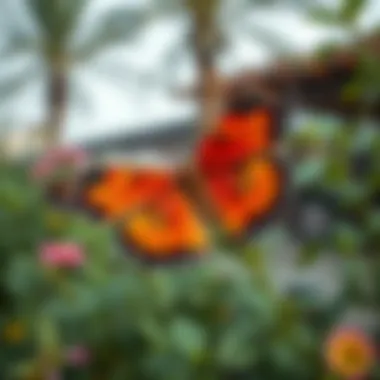

"A visit to the Butterfly Garden is not merely a stroll through a beautiful space; it’s an opportunity to understand the delicate ecosystems we share the planet with."
Photography Opportunities
The Butterfly Garden is a visual feast, offering countless photographic opportunities for both amateur and professional photographers. As visitors stroll along winding paths lined with lush vegetation and blooming flowers, they encounter numerous settings ideal for photography. Butterflies resting on vibrant petals or in mid-flight create captivating images, making this garden a haven for nature photography enthusiasts.
For photographers, the morning hours provide the best natural light, illuminating the vivid colors of the butterflies and plants alike. Here are a few tips to enhance the photographic experience at the garden:
- Utilize Macro Settings: Those interested in detailing the intricate patterns on butterfly wings should explore macro settings on their cameras, allowing for a closer, more personal view.
- Be Patient: A great photograph often requires waiting for the right moment. Keeping still and observing can lead to unexpected and stunning captures as butterflies respond to their environment.
- Respect Nature: Lastly, it’s vital for photographers to be respectful of the butterflies and their surroundings. Maintaining a safe distance ensures that the delicate creatures aren't startled, allowing for genuine moments to be captured without disruption.
In realizing the potential for photography, the Butterfly Garden also features strategically placed scenic backdrops designed to frame the natural beauty. These setups provide tourists with opportunities to take memorable photos that celebrate their experience, all while promoting an appreciation for this remarkable ecosystem.
Nearby Attractions
The Butterfly Garden in Dubai is not just a remarkable destination for butterfly enthusiasts; it is also strategically located near several attractions that enhance the overall visitor experience. Exploring these nearby sites can provide a fuller understanding of Dubai's vibrant culture and recreational offerings. This connectivity emphasizes the garden's role not only as a stand-alone marvel of biodiversity but also as part of a larger tapestry of attractions in the area.
Theme Parks and Recreational Areas
Adjacent to the Butterfly Garden, you'll find an array of world-class theme parks and recreational spaces, making it easy for families and thrill-seekers to plan a full day of enjoyment.
- Dubai Parks and Resorts: This expansive complex comprises several parks, including Motiongate, Legoland, and Bollywood Parks. Each caters to different tastes, whether you're seeking high-speed roller coasters or thematic adventures perfect for younger audiences.
- Aquaventure Waterpark: Located at the iconic Atlantis, The Palm, this waterpark is not just a place to cool off but an experience that offers attractions ranging from lazy rivers to plunge slides, attracting both tourists and locals alike.
- Global Village: Open during the cooler months, this seasonal attraction is a cultural extravaganza that showcases art, cuisine, and performances from various countries, making it a great stop after visiting the Butterfly Garden.
Connecting these destinations provides visitors the opportunity to seamlessly integrate thrills with tranquil moments spent surrounded by butterflies.
Cultural Institutions and Museums
When exploring the area around the Butterfly Garden, one must not overlook the cultural institutions and museums that contribute significantly to Dubai's artistic and historical landscape. These venues offer a deep dive into the emirate's rich heritage and also highlight the interconnectedness of nature and culture.
- Dubai Museum: Located in the historic Al Fahidi Fort, this museum showcases the transformation of Dubai from a fishing village to a cosmopolitan city. The exhibits provide a backdrop that complements the ecological themes found in the butterfly garden.
- Etihad Museum: This modern facility is dedicated to the history of the United Arab Emirates. Its architectural design and interactive displays foster a sense of national pride—an excellent complement to the tranquility experienced in the garden.
- The Dubai Opera: While primarily known for its world-class performances, the venue itself is an architectural marvel. Its proximity encourages visitors to engage with both the natural and artistic sides of the city.
By visiting these nearby attractions, guests of the Butterfly Garden can create a well-rounded experience, merging leisure and education. Each surrounding site adds its own flavor to the exploration of Dubai, affirming the importance of understanding environmental context within urban spaces. This interplay of nature and culture enhances the significance of the Butterfly Garden as not only a destination but a part of Dubai's broader landscape.
Sustainability Initiatives
Sustainability is no longer just a buzzword; it is a necessity, especially in a rapidly developing metropolis like Dubai. The Butterfly Garden not only serves as a stunning place for visitors but also highlights many sustainability initiatives that are crucial for our planet's health. These initiatives engage locals and tourists, showing the importance of ecological balance while promoting biodiversity.
Eco-Friendly Practices
Butterfly Garden employs several eco-friendly practices that underpin its commitment to the environment. It features native plants that thrive in the local climate, minimizing water usage while creating a suitable habitat for butterflies. These plants do not require chemical pesticides, thus fostering a natural ecosystem where insects can flourish without harmful chemicals.
Furthermore, the garden promotes organic gardening techniques. This involves using compost made from organic waste to nourish plants—turning “waste” into something beneficial. Such practices are vital not only for the butterflies but also for the surrounding urban environment, encouraging residents to adopt similar eco-friendly approaches in their own gardens.
- Native Flora: The garden incorporates plants indigenous to the region, which require less maintenance and water.
- Natural Pest Control: By avoiding chemical pesticides, the garden maintains a healthy ecosystem for its butterfly species.
- Composting: Organic waste is converted into compost, promoting soil health and reducing landfill waste.
Waste Management Strategies
In addition to eco-friendly practices, the Butterfly Garden has implemented robust waste management strategies, ensuring that waste minimization is part of its operational backbone. Trash bins are strategically placed throughout the garden, making it easy for visitors to dispose of their garbage properly.
The garden emphasizes recycling, with clear signage indicating where different types of waste should go. Plastics, paper, and compostables have designated areas, which fosters an environmentally-aware mindset among guests.
It also partners with local businesses to manage waste more effectively. They often work together on initiatives that focus on reducing single-use plastics and promoting reusable products among visitors. These actions align well with global sustainability goals and reinforce the garden’s role as a leader in environmental stewardship.
- Recycling Stations: Clearly marked bins encourage visitors to sort waste correctly.
- Partnerships: Collaborates with local businesses to minimize waste and promote sustainable practices.
- Awareness Programs: Offers workshops and materials to educate the public on effective waste management.
Maintaining the ecological balance is not just the responsibility of the garden; it is a collective commitment of the community. By embracing sustainability initiatives, the Butterfly Garden not only protects its delicate inhabitants but also sets a precedent for future urban gardens.
These sustainability initiatives are indispensable for fostering a culture of conservation and inspiring a new generation to appreciate and protect biodiversity. As we explore the vibrant world of butterflies, we also uncover our responsibility to ensure their habitat remains intact for future generations.
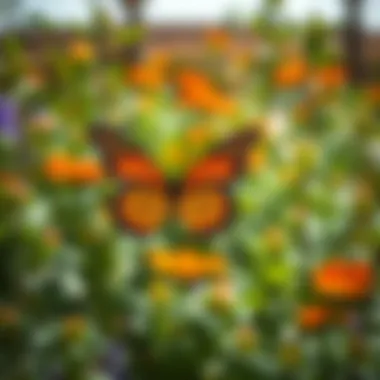

Cultural Significance of Butterflies
Butterflies, with their vibrant colors and delicate forms, hold a unique place in the cultural fabric of societies around the world. Their presence goes beyond mere aesthetic appeal; they serve as potent symbols in various cultures, often embodying transformation, beauty, and the fragility of life itself. The symbols attributed to butterflies resonate deeply with the themes of change—a reflection of nature's seasons and an echo of human experiences.
In the context of the Butterfly Garden in Dubai, this cultural significance enhances the visitor experience. It provides not only enjoyment but also a deeper understanding of the ecological relationships and cultural narratives that surround these creatures.
Symbolism in Various Cultures
Across different cultures, butterflies carry rich symbolic meanings. In many ancient traditions, they represent rebirth and new beginnings. For instance, in Chinese culture, the butterfly signifies love and joy, often depicted in art and poetry to reflect these sentiments. Native American tribes also view butterflies as messengers from the spirit world, reinforcing the belief in the interconnectedness of life.
In addition, butterflies feature prominently in the Japanese culture, where they are celebrated as symbols of the soul. The delicate nature of butterflies draws parallels with human emotions, conveying the ephemeral beauty of life. This notion transcends generations, shaping traditional stories and contemporary expressions alike.
As visitors roam the pathways of the Butterfly Garden, they engage with these narratives, pondering how these fragile beings mirror their own experiences of growth and transformation. This cultural connection enhances the appreciation of biodiversity, urging a more profound respect for the delicate balance of life.
Impact on Local Art and Design
The influence of butterflies extends into the realm of art and design, particularly within the local context of Dubai. Local artisans and designers often draw inspiration from the grace and complexity of butterfly anatomy. This manifests in various creative expressions—furniture designs that mimic the wings of these insects, textile patterns adorned with vibrant butterfly motifs, and outdoor sculptures that pay homage to their beauty.
Moreover, the garden serves as a living canvas, enabling artists to explore themes of nature and conservation. Events or exhibitions held at the Butterfly Garden may showcase local artists' work, intertwining artistic expression with the ecological significance of butterflies. This fusion of culture and nature not only supports local talent but also fosters environmental awareness, encouraging a dialogue on sustainability.
The Butterfly Garden acts as a cultural bridge, connecting visitors with the artistic heritage of the region while reminding them of their role as stewards of the environment. As they observe the fluttering butterflies, they are invited to reflect on their impact on culture, art, and the fragile ecosystems that thrive around them. The beauty of these insects offers an opportunity for introspection, inviting all to consider how their own lives intertwine with the natural world.
"For the butterfly, new beginnings are returned to the heart, reminding us life is full of transformative moments."
Through these cultural lenses, the Butterfly Garden in Dubai becomes not just a picturesque retreat but a vital educational hub, fostering a nuanced understanding of both biodiversity and the rich tapestry of human experience that butterflies weave through art and culture.
Visitor Information and Help Section
When planning a trip to Dubai's Butterfly Garden, having clear and relevant visitor information can enhance the experience significantly. This section is essential as it addresses practical considerations that can affect the enjoyment of the garden. From understanding opening hours and ticket prices to navigating accessibility options, providing this information ensures all guests can engage with this ecological wonder comfortably and without hassle.
Opening Hours and Ticket Prices
The Butterfly Garden in Dubai opens its doors to visitors year-round, allowing butterfly aficionados and curious nature lovers to explore its vibrant habitats. Generally, the garden operates from 9:00 AM to 6:00 PM. These hours can vary slightly during public holidays or special events, so it's worthwhile to check their official website before planning your visit.
As for the cost of entry, the pricing model is structured to be family-friendly. Adult tickets typically range from 50 to 60 AED, while children's tickets are about 40 AED. Purchasing tickets in advance online may sometimes offer discounts or special packages that cater to families.
"Visitor knowledge of pricing and hours contributes significantly to a fulfilling experience, minimizing surprise costs or scheduling conflicts."
Accessibility Options
Ensuring that the Butterfly Garden is accessible to everyone is a core consideration of its design and operational policies. Wheelchair ramps are available throughout the garden, allowing those with mobility challenges to navigate the various zones easily. Furthermore, there are companion tickets available at a reduced price for caregivers accompanying persons with disabilities.
Public transportation options are plentiful as well. Visitors can catch the metro to the nearest station, followed by a short bus or taxi ride to the garden entrance. Parking facilities are expansive, providing both shaded and uncovered spots for vehicles. For those who prefer to cycle, bike racks are available nearby, encouraging alternative and eco-friendly modes of transport.
With these access measures in place, the Butterfly Garden aims to offer a welcoming environment for all, allowing everyone to appreciate the lush surroundings and delicate creatures fluttering around.
Acquainting oneself with the visitor information enhances the experience, ensuring that every guest can navigate the Butterfly Garden seamlessly.
Culmination
Reflections on the Butterfly Experience
Engaging with the Butterfly Garden in Dubai is not merely about witnessing the colorful flutter of wings; it's an immersive experience that resonates deeply within. Visitors often report a sense of tranquility and wonder—a momentary escape from the bustling city life. The delicate balance of nature present in the garden serves as a poignant reminder of the fragility of ecosystems. In a world where urbanization often overshadows the natural, the garden stands as a vibrant testament to biodiversity. It doesn't just showcase butterflies; it invites individuals to reflect on their connection to nature, the importance of conservation, and the need to protect these delicate creatures. A stroll through the winding paths filled with lush flora and fluttering wings can leave one with a renewed perspective on environmental stewardship.
Future Developments and Goals
Looking ahead, the Butterfly Garden aims to expand its educational outreach and enhance its conservation initiatives. Plans are underway to introduce more interactive exhibits that focus on sustainability and the vital role butterflies play in our ecosystem. Not only will visitors gain a deeper understanding of the garden’s inhabitants, but they will also be encouraged to take part in conservation efforts beyond their visit.
The garden's management envisions partnerships with schools and local organizations, creating programs that foster a sense of responsibility towards the environment. By spearheading community engagement projects, they aspire to cultivate a culture of eco-awareness that extends beyond the garden's boundaries. Directly involving the public in practical conservation efforts could spark a movement towards greater environmental accountability, ensuring that future generations inherit a thriving ecosystem.
"In every butterfly, there is a story of resilience and transformation, urging us to strive for a world that cherishes nature."
For further information regarding conservation practices, families can explore resources like www.butterflyconservation.org and visit educational databases such as en.wikipedia.org.










